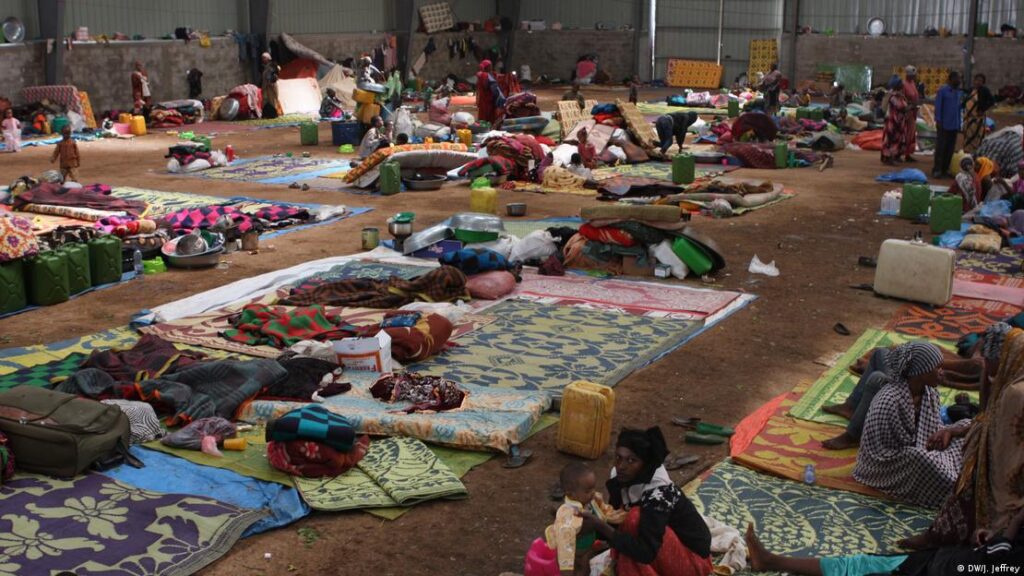This article aims to present facts about internally displaced persons in Oromia and discuss the implications of peace talks for them. Future articles will illuminate the ways that Oromo IDPs specifically are made invisible, remaining uncounted and ignored.
The recent announcement of peace talks between the Ethiopian government and the Oromo Liberation Army (OLA) is a welcome relief for the people of Oromia and neighboring regions, who have lived with the daily threat of violence for many years. It is still too early to tell whether a Tigray-style peace agreement will be reached, and if so, whether such an agreement will hold. However, even if hostilities come to an end, major questions remain about whether life will improve for civilians. Perhaps for no group is this more of a concern than the estimated 5.1 million Ethiopians, including many Oromos, who have been living as internally displaced persons (IDPs).
IDPs live a particularly precarious existence, somewhere between a refugee and a full citizen of their home countries. Because they have not crossed an international border, IDPs do not always have access to the services that refugees do. They are still within the confines of their country of origin, which means they are subject to their own government. If that government denies IDPs access to services or otherwise does not provide for their needs, it can be difficult for international institutions such as the UN or humanitarian organizations to step in without infringing on national sovereignty and potentially placing their workers in harm’s way. Such is the case for Ethiopian IDPs.
Ethiopia’s IDPs are living in unacceptable conditions
According to the International Organization for Migration’s (IOM) best estimate, Oromia was home to 959,712 IDPs in 2022. This was second only to the Somali region (1,263,155). These numbers are likely gross underestimates, however, as the IOM itself notes. Indeed, in its National Displacement Report #15, the IOM identified several sites in Oromia that were unreachable by assessment teams due to security issues, including in Guji, West Guji, West Wollega, Kelem Wellega, East Wollega, Arsi, West Shewa, and North Shewa. UN OCHA estimates that Western Oromia alone hosts about 725,000 IDPs. The rate of growth in IDP populations is especially high in Oromia, with nearly 40 percent of all displacements in the last year occurring in the region. Oromia is also home to the vast majority (71.3 percent) of people who have been displaced for 10 years or more. Worryingly, sources also indicate that IDPs in Oromia tend to only be considered displaced for the first six months, another factor that contributes to undercounting.
Conflict continues to displace people in Ethiopia, but climate change is a major driver in Oromia, especially given the multi-year drought that has devastated farming and pastoral livelihoods. Even the non-displaced residents of Oromia have felt neglected by the government for decades. Indeed, violence and the destruction of infrastructure have hampered humanitarian access in Oromia, in addition to forcing school and hospital closures.
The conflict between the Oromia and Somali regions that began in 2017 drove many ethnic Oromos out of Somali, and many ethnic Somalis out of Oromia. The ethnic Oromos who arrived as IDPs in Oromia have met with outright hostility despite their shared ethnicity with host communities. Jafer (2022) conducted interviews with IDPs in Oromia Special Zone and found that members of the host community tend to have better access to basic services and employment, whereas IDPs lack the social networks needed to reach these opportunities. Instead, discrimination has led to IDPs working the same jobs as hosts for less pay, and they overall work in more precarious circumstances. This discrimination is in part based on IDPs’ tendency to be Muslims, while many host community members are Christian. However, host community members also see IDPs as competition for limited employment opportunities.
Government promises of aid have largely gone unfulfilled, and what services exist are woefully inadequate. The shelters provided to IDPs are poorly constructed and leave them exposed to the elements, and there is a lack of safe drinking water nearby. Toilets are dangerously constructed, and one child even died after falling into an uncovered latrine hole. Reports to the government went unanswered, and IDPs have found the police to range from apathetic to threatening when they try to report concerns. In addition, IDPs suffer from greater poverty than their host neighbors and were forced to use government loans to buy food, rather than to establish businesses. Hunger has become so acute that some IDPs have resorted to begging, despite the fact that nearby markets have food available. It is simply out of reach for them, and the government has not responded to repeated pleas for assistance.
Oromo IDPs have thus been walking an uncomfortable line that is familiar to IDPs worldwide: invisible to their government, but all too visible to their host community. They are not asking for much, simply safe homes and dignified work that will allow them to feed themselves and their families. However, the IDPs are barred from forming self-help organizations, possibly due to the historic success of the Macha-Tulama Self Help Association, which formed the base of Oromo resistance against government oppression. Notably, even those IDPs who have received international aid lack employment opportunities and stable housing.
Ethiopia’s IDPs, in particular the Oromos, are thus among the most marginalized people in the country. Oromos already have a strained relationship with their government, which has roots in Abyssinian colonization and has sought to repress Oromo pride and identity. Now these individuals are even more neglected by their government, forced to live on the fringes of society even in places where they share an ethnicity with their hosts. The roots of IDPs’ distrust of and disconnect from their government run deeply, and it will take more than words to heal those wounds.
Will the peace talks bring change?
Though both the government and the OLA expressed cautious optimism about the first round of peace talks in mid-May, fighting between the two groups continued. Oromia residents have recently accused the government of burning down their homes, allegedly on the suspicion that they were harboring OLA fighters. The already-fragile situation has deteriorated so much that one Oromo Liberation Front (OLF) politician expressed doubt that there would be a second round of peace talks. The government has not helped to ease people’s doubts, staying largely silent in the face of the OLA’s accusations of a government offensive.
This is a position the Ethiopian government can ill afford. Its trust level with its own people is already quite low, and its international reputation was badly shaken by the war in Tigray. The government has been credibly accused of ethnic cleansing and crimes against humanity in the war. Many parties, including the United States, have pointed to the Tigray peace deal as a model for Oromia, but thus far it is unclear whether the accords have provided much benefit. Roughly 90 percent of Tigray’s population still relies on humanitarian aid, with reports that hunger is still a problem. Journalists have only limited access to the region, making it difficult to confirm progress. In addition, the government has on multiple occasions abducted or imprisoned journalists without compelling evidence of crimes committed, generating skepticism that it is a truly neutral actor willing to work with all parties toward peace and political freedoms.
The way forward
A formal end to hostilities is a critical first step, but it truly is only the first step of many. Substantive peace is more than just a lack of active conflict. Potential returnees to and from Oromia have dealt with abuse and deprivation for over a century, the effects of which have been exacerbated in recent years by the climate crisis. There is little left for them to build upon besides their own resilience and sense of connection to their communities. Remarkable though these characteristics are among the Oromo and other historically oppressed minorities, they alone cannot carry returning IDPs through. Return and reintegration are complex processes even after short displacements, but some people in Ethiopia have been displaced for decades. It will take substantial effort on the part of the government to ensure adequate housing, infrastructure, food security, education, health care, and livelihoods for returnees, and guarantees of safety are a necessity for a population that has lived so long in the shadow of violence.
Other Oromos may choose to stay in their resettlement communities. Their continuing needs must not be forgotten in any plans to reintegrate IDPs and recover from the recent surge in conflict. The government has had years to fulfill its obligation to secure these citizens’ basic needs and it has failed to do so. Their social, political, and economic rights have been so thoroughly trampled on that only a serious, sustained intervention can restore what should have been theirs all along. Importantly, though host communities have generally fared better than the IDPs sharing their towns, their needs must be considered as well. The environmental and economic impact of a sudden increase in population affects everyone.
The logistical challenges facing the Ethiopian government are considerable, but even the most sophisticated and well thought-out technocratic solutions will fall flat without trust-building between the government and its people. A population that has seen their rights repeatedly violated and watched indiscriminate violence tear apart their communities will need more than speeches and signed papers to convince them that change is coming. Visible signs of demobilization and acts of good faith, such as the inclusion of Oromos and members of other ethnic groups in the planning phases of recovery projects, will be key for building trust. Preferably, reforms should extend all the way to the level of the national government. Many Ethiopian citizens have long called for a more inclusive system of government that recognizes the complex makeup of the country and acknowledges various groups’ cultural and economic rights, in addition to their right to political inclusion. With so many citizens displaced, any system that fails to include them is doomed.
The simplest way to ensure inclusion of IDPs is to ask them. These people are not voiceless, they are silenced or ignored. Indeed, one IDP interviewed recently specifically cited the need to include IDPs in the peace process, noting that most have lost everything and understand that they deserve compensation. What if, for once, we trust people to understand their own needs, and allow them to inform the processes that shape their lives?




